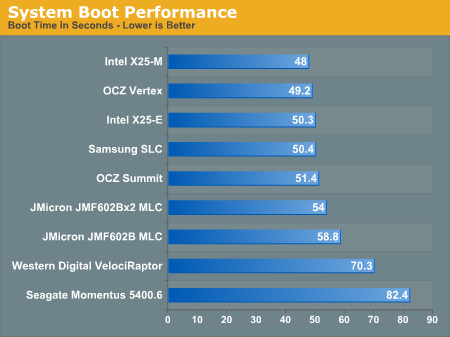The SSD Anthology: Understanding SSDs and New Drives from OCZ
by Anand Lal Shimpi on March 18, 2009 12:00 AM EST- Posted in
- Storage
Application Launch Times
You know the drill; grab a stop watch and let's see how fast some of these apps run. The first on the list was just how long it takes to boot my application testbed. This is a fully configured machine with over 50GB of applications and data. I started timing as soon as I hit the power button and stopped it as soon as I got to the Windows desktop. Note that around 15 seconds of the boot takes place before the machine ever finishes its POST:

Most of the SSDs perform similarly here and all of them are a good 20 - 30% faster than the WD VelociRaptor.
I tried launching Adobe Photoshop CS4:

Not all applications will launch faster than a VelociRaptor on a SSD, but let's not forget that the VelociRaptor is the world's fastest consumer desktop hard drive. Put one of these SSDs in a notebook and you'll completely redefine the word performance.











250 Comments
View All Comments
zdzichu - Sunday, March 22, 2009 - link
Very nice and thorough article. I only lack more current status of TRIM command support in current operating systems. For example, Linux supports it since last year:http://kernelnewbies.org/Linux_2_6_28#head-a1a9591...">http://kernelnewbies.org/Linux_2_6_28#h...a9591f48...
Sinned - Sunday, March 22, 2009 - link
Outstanding article that really helped me understand SSD drives. I wonder how much of an impact the new SATA III standard will have on SSD drives? I believe we are still at the beginning stage for SSD drives and your article shows that much more work needs to be done. My respect for OCZ and how they responded in a positive and productive way should be a model for the rest of the SSD makers. Thank you again for such a concise article.Respectfully,
Sinned
529th - Sunday, March 22, 2009 - link
The first thing I thought of was Democracy. Don't know why. Maybe it was because a company listened to our common goal of performance. Thank you OCZ for listening, I'm sure it will pay off!!!araczynski - Saturday, March 21, 2009 - link
very nice read. the 4/512 issue seems a rather stupid design decision, or perhaps more likely a stupid problem to find this 4/512 solution as 'acceptable'.although a great marketing choice, built in automatic life expectancy reduction.
sounds like the manufacturers want the hard drives to become a disposable medium like styrofoam cups.
perhaps when they narrow the disparity down to 4/16, i might consider buying an ssd. that, or when they beat the 'old school' physical platters in price.
until then, get back to the drawing board and stop crapping out these half arsed 'should be good enough' solutions.
IntelUser2000 - Sunday, March 22, 2009 - link
araczynski: The 4/512 isn't done by accident. It's done to lower prices. The flash technology used in SSDs are meant to replace platter HDDs in the future. There's no way of doing that without cost reductions like these. Even with that the SSDs still cost several times more per storage space.araczynski - Tuesday, March 24, 2009 - link
i understand that, but i don't remember original hard drives being released and being slower than the floppy drives they were replacing.this is part of the 'release beta' products mentality and make the consumer pay for further development.
the 5.25" floppy was better than the huge floppy in all respects when it was released. the 3.5" floppy was better than the 5.25" floppy when it was released. the usb flash drives were better than the 3.5" floppies when they were released.
i just hate the way this is being played out at the consumer's expense.
hellcats - Saturday, March 21, 2009 - link
Anand,What a great article. I usually have to skip forwards when things bog down, but they never did with this long, but very informative article. Your focus on what matters to users is why I always check anandtech first thing every morning.
juraj - Saturday, March 21, 2009 - link
I'm curious what capacity is the OCZ Vertex drive reviewed. Is it an 120 / 250g drive or supposedly slower 30 / 60g one?Symbolics - Friday, March 20, 2009 - link
The method for generating "used" drives is flawed. For creating a true used drive, the spare blocks must be filled as well. Since this was not done, the results are biased towards the Intel drives with their generous amount of spare blocks that were *not* exhausted when producing the used state. An additional bias is introduced by the reduction of the IOmeter write test to 8 GB only. Perhaps there are enough spare blocks on the Intel drives so that these 8 GB can be written to "fresh" blocks without the need for (time-consuming) erase operations.Apart from these concerns, I enjoyed reading the article.
unknownError - Saturday, March 21, 2009 - link
I also just created an account to post, very nice article!Lots of good well thought out information, I'm so tired of synthetic benchmarks glad someone goes through the trouble to bench these things right (and appears to have the education to really understand them). Whats with the grammar police though? geez...